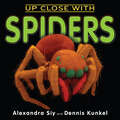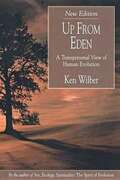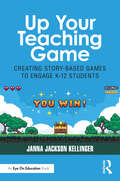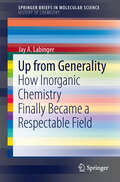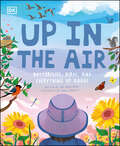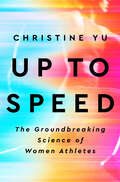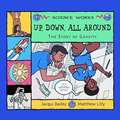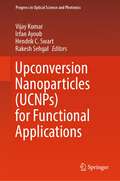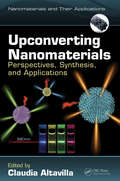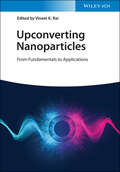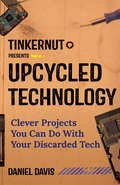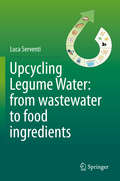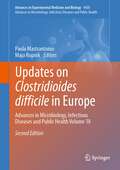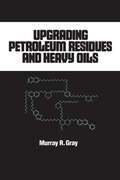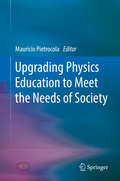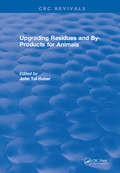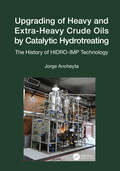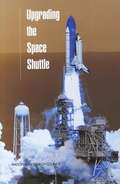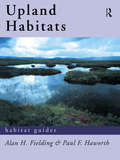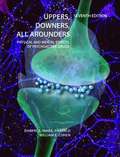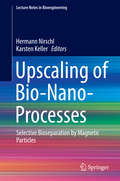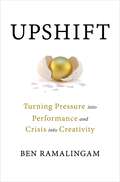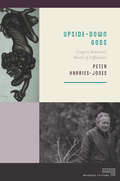- Table View
- List View
Up Close With Spiders
by Alexandra SiyDebunking myths about spiders, this book takes an extremely close look at creatures that both fascinate and terrify humans.An introduction explains what makes spiders unique. Then ten species are highlighted with incredible electron micrograph photographs and surprising facts. From diving bell spiders that live in bubbles underwater, to spitting spiders that shoot venomous wads of spit at their prey, to black widows and wolf spiders, this unusual book will intrigue readers and help dispel arachnophobia. First published in 2015 as Spidermania, this title has been repackaged as a companion to Up Close with Bugs (Bug Shots).
Up Close: A life-size look at the animal kingdom
by Isabel ThomasDid you know that the world's biggest tongue belongs to the blue whale? Or that the snub-nosed monkey's nostrils point upwards, and when it rains it makes them sneeze? From paws to claws, tongues, teeth, tails and more, compare the biggest and the smallest animals (and all the others in between) in this illustrated exploration of creatures and their features.Includes stunning 'UP CLOSE' pages, which take a life-size look at a particular feature of two very different animals. See the mighty elephant's trunk (it can grow as long as a bathtub!) and compare it to the sensitive snout of an elephant shrew. Study the bristly tongue of a penguin and see how different it is to the stretchy, long tongue of a salamander. Written by science writer and children's book author Isabel Thomas, with beautiful illustrations by Dawn Cooper, this absorbing book will delight and educate young animal lovers aged 6+.
Up From Eden: A Transpersonal View of Human Evolution
by Ken WilberThis book chronicles humanity's cultural and psychospiritual evolutionary journey over some six million years from its primal past into its dazzling cosmic future.
Up Your Teaching Game: Creating Story-Based Games to Engage K-12 Students
by Janna Jackson KellingerUp Your Teaching Game offers K-12 teachers an intuitive and refreshingly fun pathway for creating immersive, story-based games that encourage students to experience the curriculum through play. Regardless of their technical abilities, design acumen, grade level, or domain, today’s teachers have fresh opportunities to create and implement their own content-based games based on the same techniques that video game designers use to create commercial video games. In five actionable steps, this book prepares educators to design curricular games that teach instead of test, that are derived from content rather than divergent from it, and that motivate students to take ownership over their learning. Programs that most teachers are familiar with, such as PowerPoint and Google Slides, and technologies that may be new to them, such as Twine and Scratch, are addressed alongside the use of their own classrooms and schools as game spaces. Novice and veteran teachers alike, as well as curriculum designers and school technologists, will find a wealth of strategies and lessons learned, tips for avoiding pitfalls and time constraints, examples of quests and storyline advancement, and much more.
Up from Generality
by Jay A. LabingerIn this brief, renowned inorganic chemist Jay Labinger tracks the development of his field from a forgotten specialism to the establishment of an independent, intellectually viable discipline. Inorganic chemistry, with a negation in its very name, was long regarded as that which was left behind when organic and physical chemistry emerged as specialist fields in the 19th century. Only by the middle of the 20th century had it begun to gain its current stature of equality to that of the other main branches of chemistry. The author discusses the evidence for this transition, both quantitative and anecdotal and includes consideration of the roles of local and personal factors, with particular focus on Caltech as an illustrative example. This brief is of interest both to historians of science and inorganic chemists who would like to find out how their field began.
Up in the Air (Underground and All Around)
by Zoe ArmstrongLook up! What do you see? This charming nature book will encourage children to look, listen, and feel nature all around. From cloud patterns to constellations, the chirrup of a single sparrow to the trees that rustle in the wind - the beauty of nature is everywhere. This children&’s book is perfect for cultivating a love of natural science.Inside this beautifully illustrated kid's guide, Up In The Air you&’ll discover: • Cross-curriculum science topics covering botany, ornithology, meteorology, and more • Gorgeous illustrations by Sara Ugolotti create a softer approach to scientific topics - perfect for young readers between the ages of 7-9 • Plant and animal species that live above us from all around the world • A guide to bird watching for kids, cloud spotting, and identifying different constellations of stars From the tiny insects that make their homes in tree trunks to the names of the planets and constellations in the sky, there is so much to see in the world above our heads. Young readers will discover the joy nature can bring to us, and build on their understanding of the natural world.Up In The Air is the perfect introduction to climatology, astronomy, and the intricacies of flora and fauna life. Kids will learn about Earth&’s ecosystem and understand why living things are vital for our planet&’s future, whether they are insects pollinating plants, or trees helping to make the air we breathe.
Up to Speed: The Groundbreaking Science of Women Athletes
by Christine Yu&“Up to Speed is a roadmap and toolbox for athletes of all ages. Every coach should read it and discuss it with their athletes. I wish I had been able to read this book while I was competing.&” —Kara Goucher, Olympic long-distance runner and author of The Longest RaceHow the latest science can help women achieve their athletic potential Over the last fifty years, women have made extraordinary advances in athletics. More women than ever are playing sports and staying active longer. Whether they&’re elite athletes looking for an edge or enthusiastic amateurs, women deserve a culture of sports that helps them thrive: training programs and equipment designed to work with their bodies, as well as guidelines for nutrition and injury prevention that are based in science and tailored to their lived experience.Yet too often the guidance women receive is based on research that fails to consider their experiences or their bodies. So much of what we take as gospel about exercise and sports science is based solely on studies of men. The good news is, this is finally changing. Researchers are creating more inclusive studies to close the gender data gap. They&’re examining the ways women can boost athletic performance, reduce injury, and stay healthy. Sports and health journalist Christine Yu disentangles myth and gender bias from real science, making the case for new approaches that can help women athletes excel at every stage of life, from adolescence to adulthood, through pregnancy, menopause, and beyond. She explains the latest research and celebrates the researchers, athletes, and advocates pushing back against the status quo and proposing better solutions to improve the active and athletic lives of women and girls.
Up, Down, All Around: A Story of Gravity (Science Works)
by Jacqui Bailey Matthew LillyExplains the concept of gravity by taking a trip on the space shuttle. Lexile Measure: 0700
Upconversion Nanoparticles (Progress in Optical Science and Photonics #24)
by Vijay Kumar Hendrik C. Swart Irfan Ayoub Rakesh SehgalThis book explores upconversion nanoparticles (UCNPs) at both, the fundamental as well as applied levels, for functional applications. It provides a broad perspective about the synthesis approaches of UCNPs with the preferred size, improved and tunable upconversion luminescence, along with the combined multifunctionality for various applications. It highlights the fundamentals and systematic developments in the tuning of UC emission and surface engineering of UCNPs that make UCNPs convenient for use in a large range of applications. Moreover, it gives an understanding of the imposed limitations and challenges associated with these methods to achieve the desired performance in targeted applications. It also includes the latest multifunctional lanthanide-based UCNPs, which efficiently convert low-energy photons into high-energy photons, and their applications in fluorescent microscopy, deep-tissue bioimaging, nanomedicine, optogenetics, solid-state lighting, solar cells, security labeling, and volumetric display.
Upconverting Nanomaterials: Perspectives, Synthesis, and Applications (Nanomaterials and their Applications)
by Claudia AltavillaUpconverting Nanomaterials: Perspectives, Synthesis, and Applications serves as a powerful instrument that explores cutting-edge research knowledge on the topic of upconverting nanosystems, while simultaneously providing the necessary fundamental background for nonspecialist readers. The various aspects of upconverting materials are approached both from a theoretical point of view, particularly upconverting phenomenon, and a practical one. By presenting synthetic strategies, functionalization, production of core shell structures and nanocomposites, this book supplies PhD students, researchers, and scientists with a wealth of ideas they can apply to different fields of research. Thirty-five renowned scientists from around the world have collaborated to produce 11 chapters that help to "make a voyage" through the most important aspects of UPNPs, including syntheses, mechanism, functionalization, and applications.
Upconverting Nanoparticles: From Fundamentals to Applications
by Vineet K. RaiModern learning resource providing broad coverage of the rapidly-advancing field of upconverting nanoparticles This modern reference explains photon upconversion technology using nanoparticles from first principles to novel and future applications in imaging, sensing, catalysis, energy technology, biomedicine, and many other areas. Expert authors discuss both established and novel materials and applications, going far beyond the coverage of previously published books on the subject. Key topics covered in the book include: Synthesis, characterization, and basic properties of nanoparticles with photon-upconverting properties New types of upconverting nanoparticles, including transition metal- and rare earth-doped materials, metal-organic frameworks, core/shell particles, and surface-modified particles Current and emerging application areas for upconverting nanoparticles, including heating, lighting, sensing, and detection Biomedical uses of nanoparticles, including photodynamic therapy Photon upconversion using nanoparticles has opened the door to a new universe of light-powered technology. This book is a key resource for scientists, physicists, and chemists across a wide range of disciplines who wish to master the theory, methods and applications of this powerful new technology.
Upcycled Technology: Clever Projects You Can Do With Your Discarded Tech (Tinkernut)
by Daniel T. DavisDIY science projects using old tech to create new zombie tech—an eco-friendly, fantastic way to learn about today&’s technology. We all have a drawer or closet full of old discarded tech just sitting around, gathering dust. Memories of a bygone technological era that have been replaced by newer, shiner, smarter devices. What can you do with them? Most of us don&’t even know how to properly dispose of them. If only there was a way to save them from their untimely fate. Well empty out that drawer and grab a screwdriver because the time has come to bring these old devices back from the grave! Old technology may no longer be useful, but it isn&’t useless. Hidden inside often-discarded devices is a treasure trove of motors, magnets, screens, and other parts just waiting for a chance to be upcycled! And this type of &“upcycling&” doesn&’t mean turning an old CD into a coaster, it means something a little more hardcore, like . . . · How to make a great Wi-Fi security camera with an old cell phone · How to make a basic 3D printer out of old computer disk drives · What can be made with the rare-earth magnets inside old hard drives or the reusable LCD screens in old phones · And much more Fans of Popular Science, Smithsonian&’s Maker Lab, and The Big Book of Makerspace Projects will love Upcycled Technology.
Upcycling Legume Water: from wastewater to food ingredients
by Luca ServentiFood manufacturing generates an incredibly high volume of wastewater. The legume industry is one of the top contributors to this environmental issue, as soaking and boiling are necessary to transform dried legumes into cooked canned products and other legume-based products, such as soymilk, tofu, hummus and flours. Wastewater must be treated prior to disposal into the environment, thus raising production costs for the food industry. In addition, wastewater contains nutrients that are lost from the food chain after disposal. As water and soluble nutrients are becoming a limited resource, it is critical to optimize food manufacturing at all levels. Recycling Legume Wastewater Into Food Ingredients presents a sustainable solution to this increasing demand for food and water. The text analyses the composition of legume wastewater and its physicochemical properties, including its potential applications in emulsifiers, foaming agents, gelling agents and antistaling ingredients. Early chapters discuss the processing of legumes and the wastewater generation involved. Further sections focus on wastewater generated by soaking and cooking, including the composition, functional properties, and food applications involved in each. Sprouting water, bioactives and applications in edible packaging are also discussed. In presenting a sustainable solution for legume wastewater use, this text is an important key to sustainability in food processing and the reduction of waste.
Updates on Clostridioides difficile in Europe: Advances in Microbiology, Infectious Diseases and Public Health Volume 18 (Advances in Experimental Medicine and Biology #1435)
by Paola Mastrantonio Maja RupnikThis fully updated second edition outlines the currently available clinical, epidemiological and experimental data on Clostridioides difficile infections(CDI) with special emphasis on studies and results achieved in Europe. The incidence and severity of CDI has increased significantly over the last decade, and the book explains why C. difficile, recently reclassified as Clostridioides difficile, remains a significant challenge, also from economic perspective, to health care systems all over the world. The different reservoirs of this ubiquitous microorganism are reviewed as well as the different factors contributing to its virulence, such as toxins and biofilm formation. The rapid evolution of antibiotic resistance is clearly a concern and in a specific way can influence the CDI epidemiology. Additionally, new emerging strains and comparative genomics studies are taken into consideration for their relevance from epidemiological and evolutionary point of view. The book also gives an overview on diagnostics, therapy and surveillance, all of which are still challenging. Therefore, a closer look is taken on the effect of probiotics as an alternative to antibiotics, for prevention and treatment of CDI. Fecal transplantation from healthy donors, passive immunotherapies and vaccines for patients with recurrences are also discussed in dedicated chapters. New topics included sporulation and membrane vesicles in C. difficile. The book closes with a summary of the history and the achievements of the European Society of Clinical Microbiology and Infectious Diseases Study Group for Clostridium difficile (ESGCD) written by the current and past presidents of the Society. It is the aim of this book to raise awareness on CDI and to disseminate updated information on its prevention, diagnosis and treatment.
Upgrade Your Teaching: Understanding By Design Meets Neuroscience
by Judy Willis Jay McTigheHow can educators leverage neuroscience research about how the human brain learns? How can we use this information to improve curriculum, instruction, and assessment so our students achieve deep learning and understanding in all subject areas? Upgrade Your Teaching: Understanding by Design Meets Neuroscience answers these questions by merging insights from neuroscience with Understanding by Design (UbD), the framework used by thousands of educators to craft units of instruction and authentic assessments that emphasize understanding rather than recall.
Upgrading Petroleum Residues and Heavy Oils
by R. Murray Gray"This useful reference offers in-depth coverage of current techniques for converting heavy oils and residues into more valuable distillates.Examines the chemistry of heavy hydrocarbon feeds and their properties important to engineering design, including phase behavior, reaction kinetics, and thermodynamic and transport characteristics!"
Upgrading Physics Education to Meet the Needs of Society
by Maurício PietrocolaNations around the globe consider physics education an important tool of economic and social development and currently advocate the use of innovative strategies to prepare students for knowledge and skills acquisition. Particularly in the last decade, a series of revisions were made to physics curricula in an attempt to cope with the changing needs and expectations of society. Educational transformation is a major challenge due to educational systems’ resistance to change. Updated curriculum content, pedagogical facilities (for example, computers in a school), new teaching and learning strategies and the prejudice against girls in physics classes are all issues that have to be addressed. Educational research provides a way to build schemas and resources to promote changes in physics education. This volume presents physics teaching and learning research connected with the main educational scenarios.
Upgrading Residues and By-products for Animals
by J. Tal HuberAccumulation into one source of what is known regarding the feeding value of these materials and systems which have been developed for improving their digestibility, palatability or methods of handling was the motivation for organising this book. These has been an effort to include the major categories of unconventional materials which can potentially be upgraded to provide the ruminant with needed nutrients, but certainly some have been missed. It is hoped that this treatise will prove to be a valuable tool for workers involved in improving the utilization of residues and waste products for animals.
Upgrading of Heavy and Extra-Heavy Crude Oils by Catalytic Hydrotreating: The History of HIDRO-IMP Technology
by Jorge AncheytaThis book explores the common approaches to upgrade heavy and extra-heavy crude oils by means of catalytic hydrotreating, emphasizing hydrogen addition technology as well as carbon rejection alternatives. Kinetic and reactor models are combined with experimental data to simulate and optimize commercial-scale reactor performance. Key Features• Focuses on fixed-bed catalytic hydrotreating and catalysts and process scheme characteristics for commercial application.• Guides readers on hydrotreating process technology development from batch reactor experiments to semi-commercial test.• Describes step-by-step methodologies for development of kinetic models based on experimental data generated at different reaction scales.• Provides detailed explanation on how to formulate a reactor model for the simulation of catalytic hydrotreating of heavy oils. A comprehensive guide to the upgrading of crude oils, this book has particular appeal for petroleum refining industry professionals, catalyst developers, workshop instructors, professors, and their graduate and postgraduate students.
Upgrading the Space Shuttle
by Committee on Space Shuttle UpgradesThe National Academies Press (NAP)--publisher for the National Academies--publishes more than 200 books a year offering the most authoritative views, definitive information, and groundbreaking recommendations on a wide range of topics in science, engineering, and health. Our books are unique in that they are authored by the nation's leading experts in every scientific field.
Upland Habitats (Habitat Guides)
by Alan F. Fielding Paul F. HaworthUpland Habitats presents a comprehensive illustrated guide to the habits wildlife and conservation of Britains last wilderness areas. These include: heather moors, sheep walk deer forest, blanket bogs, montane and sub-montane forests. The book examines the unique characteristics of uplands and the ecological processes and historical events that have shaped them since the end of the last glaciaton. Among the key conservation and management issues explored in are:* modern agricultural practices and economics* habitat degradation through overgrazing* commercial forest plantations* the persecution of wildlife* recreation in the uplands* the funding of upland farming.
Uppers, Downers, All Arounders: Physical and Mental Effects of Psychoactive Drugs
by Cns Productions IncOver 400 colleges and universities have adopted this up-to-date user-friendly textbook addressing psychoactive drugs and compulsive behaviors. Wide-ranging research and extensive citations make this an excellent reference source. A companion Study Guide containing chapter outline, guided review, practice tests, a drug identification table, and an extended glossary is available to download with each copy. Key ideas and concepts are highlighted throughout the book. This technique along with the Study Guide aids readers in processing the materials. Instructor support materials are also available. The content relies on the most current data and studies as well as practical information and interviews drawn from treatment professionals and their clients. The material gives perceptive insights into the complex fields of drug abuse, compulsive behaviors, addiction, treatment, recovery, and prevention. QR (quick response) codes access short videos for each chapter, and hundreds of illustrations, photos, and graphics make this clearly, concisely, and simply written textbook valuable to instructors, students, and professionals alike.
Upscaling of Bio-Nano-Processes
by Hermann Nirschl Karsten KellerDespite ongoing progress in nano- and biomaterial sciences, large scale bioprocessing of nanoparticles remains a great challenge, especially because of the difficulties in removing unwanted elements during processing in food, pharmaceutical and feed industry at production level. This book presents magnetic nanoparticles and a novel technology for the upscaling of protein separation. The results come from the EU Project "MagPro2Life", which was conducted in cooperation of several european institutions and companies.
Upshift: Turning Pressure into Performance and Crisis into Creativity
by Ben RamalingamWith over two decades’ experience both observing and interpreting how people channel disaster into opportunity in the most extreme circumstances and environments on Earth, Ben Ramalingam has a unique vantage point from which to identify the key principles that can enable anyone to use stress as an opportunity for change.In Upshift, Ramalingam distils this expertise into an insightful, powerful, and engaging book that will show you how to reframe your set responses to stress and pressure and instead use them to harness the potential they hold not just for improving your work, your relationships, and your mindset, but for transforming them.Upshift takes readers on an epic journey from early humans’ survival of the Ice Age to present times in our inescapable, pernicious and ever-shifting digital landscape. You will hear remarkable stories from a vast range of upshifters—all of whom carved new routes around perceived barriers using their powers to upshift. Underlying stories of how city commuters navigate train cancellations to how astronauts deal with life-threatening incidents, is one key message: We all have the power to innovate, whether or not we identify ourselves as creative or extraordinary.Maybe you’re the challenger, who thrives by constructively disrupting the status quo like Greta Thunberg. Or perhaps you find yourself constantly tweaking, prodding, breaking, rebuilding, and improving like crafters such as the team that revolutionized space travel called the NASA Pirates. Do you love introducing people whose combined efforts will lead to greater achievements? You might be a connector, like master networker Ariana Huffington.In a runaway world that is an engine for perpetual crisis, Upshift is not only an essential toolkit for survival, it is a roadmap for positive, and potentially life-changing transformation and influence. You don’t have to shut down – you can upshift.
Upside-Down Gods: Gregory Bateson's World of Difference (Meaning Systems)
by Peter Harries-JonesThis intellectual biography covers the trajectory of Bateson’s career, from his anthropological work in Bali alongside his wife, Margaret Mead, to his contributions to family therapy in the United States, and to studies of recursion as a feature of communication patterns in both the human and in the animal world. Layers of feedback with their many differing contexts, highlight the presence of meaning in social relations in contrast to that absence of meaning, purposefully proposed, within information theory. Throughout the human and in the animal world, recursion of feedback accounts for grasp of patterns, their difference, and with ability to communicate, enable transduction of perceptions of difference.Bateson’s insistence on feedback and communication re-frames many aspects of culture, psychology, biology, and evolution. His legacy is recognized as an important precursor to the formation of a new science called Biosemiotics.Harries-Jones argues that Bateson turns conventional causality upside down through showing how humanity’s perceptions, as with perceptions of all sentient beings, are anticipative. All sentient beings abduct from recursive patterns, rather than relying on linear evidence gathered about time/space movements of objects. Thus circular pattering provides clearer perceptions of the difference between sustainable creativity and current biocide, between our appreciation of nature’s aesthetics and time/space ‘games of power’ which underlie so many social and biological theories.
